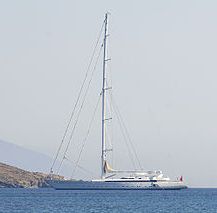
Mirabella V at Rineia, Cyclades in 2008
I recently read of the successful sea-trial of the remodeled super-yacht M5, (ex Mirabella V.) They were testing what is described as the “new carbon rig.” The new rig includes 34 new carbon fibre stays and titanium fittings with built-in dynamic fiber optics, which decreases the weight of the rig by 18 tonnes. The M5 is the largest single-masted yacht with a sail area of 3,380 m² / 36,490 sq ft. To put that in perspective, that is more sail area than the clipper ship Cutty Sark which had a sail area of around 32,000 sq ft spread over three masts. The M5‘s single mast soars to 292 feet above the waterline.
The M5 is still smaller and carries less sail than the three-masted Bermuda rigged schooner Eos, which is 305 long, counting the bowsprit and sets an impressive 3,600m² / 38,750 sq ft. of sail.
As impressive as these rich boy’s toys may be, they still do not surpass the sail area of the windjammers of the late 19th and early 20th centuries. The four masted Flying P Line Passat could set over 40,000 sq feet of sail, while the five masted Preußen set over 70,000.
While I have never particularly cared how the super-rich spend their money, it is interesting to speculate the sort of modern windjammer which might be possible with today’s materials and engineering. The mighty Preußen was only slightly over 8,000 DWT. What sort of rig would be needed to power a 110,000 DWT Capesize bulker?

As you may know, Rupert Murdoch recently sold his 186′ yawl, the Rosehearty, following his divorce. To put the size of that boat in perspective; the Constitution, bowsprit tip to stern, is 220′. So the Rosehearty is roughly the size of the Constitution, stem to stern.
Every so often the subject surfaces about a return to merchant sail for bulk cargoes. The subject then seems to quietly submerge again. Sad, since, as you mention, the current advances in materials and technology could make such a thing a reality.